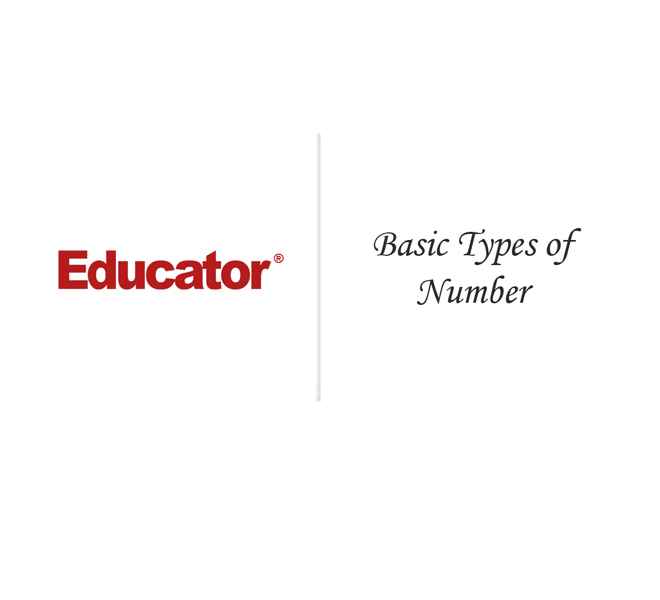Connecting...

This is a quick preview of the lesson. For full access, please Log In or Sign up.
For more information, please see full course syllabus of Algebra 1
For more information, please see full course syllabus of Algebra 1
Algebra 1 Basic Types of Numbers
Lecture Description
In this first Algebra lesson we are going to take a look at basic types of numbers and how to represent numbers with a number line. Each type is explained in detail in the video, and you'll see how a particular number may belong to more than one type. For example, the number 2 is a natural number, as well as an integer, a rational, and a real number. You can also plot numbers onto a number line. In a number line the smaller numbers are written on the left of the larger numbers. Remember that the absolute value of a number is its distance from zero on a number line.
Bookmark & Share
Embed
Share this knowledge with your friends!
Copy & Paste this embed code into your website’s HTML
Please ensure that your website editor is in text mode when you paste the code.(In Wordpress, the mode button is on the top right corner.)
×
- - Allow users to view the embedded video in full-size.
Next Lecture
Previous Lecture









































 Carleen Eaton
Carleen Eaton Grant Fraser
Grant Fraser Eric Smith
Eric Smith
 Answer Engine
Answer Engine



0 answers
Post by Hong Yang on June 9, 2020
by the way how do you determine when you use addition principal and subtraction PRINCIPAL.
2 answers
Wed Mar 18, 2020 11:57 AM
Post by Maggie Liu on March 16, 2020
The 5 in example 5 for the slides is a V
2 answers
Last reply by: Sean Zhang
Thu Jun 20, 2019 5:28 PM
Post by Sean Zhang on June 20, 2019
Just a question about the 12 in example 2, shouldnt't it also be integer whole and natural?
5 answers
Last reply by: ???
Wed Mar 27, 2019 11:11 AM
Post by Ana Chu on July 31, 2017
Hello Eric! I have a question from this course.
When you say Pi can't be a written as a fraction, I thought you could have wrote Pi over 1 (?/1) which will be 3.141592653. You also can put Pi over Pi (?/?) and get a final number of 1. Can you please help me understand if Pi can be a rational number.
Thank you!
1 answer
Mon Jul 10, 2017 4:49 PM
Post by Mohamed E Sowaileh on July 10, 2017
Hello Dr. Eric Smith,
I hope you are very well.
I am a student who is extremely weak in math. In order to be very strong in math, specially for engineering field, could you provide me with sequential order of mathematical topics and textbooks. With what should I begin so that I can master big topics like calculus, statistics, probability ... etc.
Your guidance is precious to me.
Thank you so much.
2 answers
Last reply by: Rowen Ainslie
Tue Jun 6, 2017 10:03 AM
Post by Zacc A on March 30, 2017
How is the ?{100} irrational? Isn't it rational?
1 answer
Fri Aug 26, 2016 7:01 PM
Post by Summer Breeze on June 22, 2016
Hello Eric, you said in one of the slides that imaginary numbers are numbers with i and constant like 'pie', but in this exercise, you categorize 'pie' as a real number. Can you please tell me which numbers fall under immaginary and where constants like 'pie' and 'e' go? thanks!
1 answer
Fri Aug 26, 2016 7:02 PM
Post by Summer Breeze on June 21, 2016
Hello Eric, Can I consider all numbers to be real numbers except for imiginary numbers or the square roo of a negative number?
1 answer
Fri Aug 26, 2016 7:03 PM
Post by Summer Breeze on June 21, 2016
Hello Eric, at the highest level, we have real and imaginary numbers; in your diagram, you have irrational under Real umbrella. Should irrational numbers fall under the imaginary category?
1 answer
Fri Aug 26, 2016 7:04 PM
Post by Summer Breeze on June 21, 2016
Hello Eric! Can you please share the easiest way to convert a repeated decimal number like 0.161616 into a fraction?
3 answers
Sat Mar 2, 2019 3:57 PM
Post by Summer Breeze on June 21, 2016
Hello! In your explanation, you mentionned that rational numbers are those that can be writen as a fraction and are terminating numbers, but 3/17 when converted to fraction does not terminate, why is rational?
2 answers
Last reply by: francisco marrero
Mon Aug 24, 2015 6:24 PM
Post by francisco marrero on July 22, 2015
Do you recommend a book to practice more equations?
1 answer
Tue Dec 30, 2014 3:39 PM
Post by Brad Cure on December 28, 2014
I like your diagram of "Basic Number Types" It provides a nice simple global view of numbers that is easy to understand.
3 answers
Wed Mar 18, 2015 10:25 PM
Post by Mohammed Jaweed on December 25, 2014
How do you plot a fraction on a number line.
3 answers
Last reply by: Douglas Williams
Tue Jan 14, 2014 8:58 AM
Post by Douglas Williams on January 7, 2014
Dear Mr. Smith, I just joined educator.com and have been studying a lot, I took a break and I was looking at some watches, the first watch I saw was water resistant to 30 meters, so I wanted to convert that to feet. so I found out that 1 m = 3.280 ft. So I got to wondering, what is the .280 ft. in inches? I know that .280 = (280/1000) but who ever heard of a thousandths of an inch? So I like painted myself into a corner, and I have been trying to just logically think it through, I drew a picture of a two number lines, etc, I just can not yet figure out how to get a precise conversion. Logically I know that 30 meters * 3.280 ft = water depth in ft. but how do I convert the hundredths of an inch to something more like a US fraction? Google says the answer is 3 and 3/8 inches what is the correlation between (280/1000) and (27/8) Do I factor? I can not grasp the concept, totally lost ugh. -Doug
1 answer
Mon Dec 2, 2013 8:47 PM
Post by Juan Manuel Gallardo on November 29, 2013
this course can help me for college admission tests?
1 answer
Tue Sep 3, 2013 6:38 PM
Post by Jonathan Traynor on August 31, 2013
You are an outstanding teacher. Thanks for all your help!!!!!
1 answer
Mon Aug 19, 2013 1:44 PM
Post by Theresa Sharp on August 19, 2013
How do I write a decimal with a repeating block of numbers as a fraction? what is the formula for that?